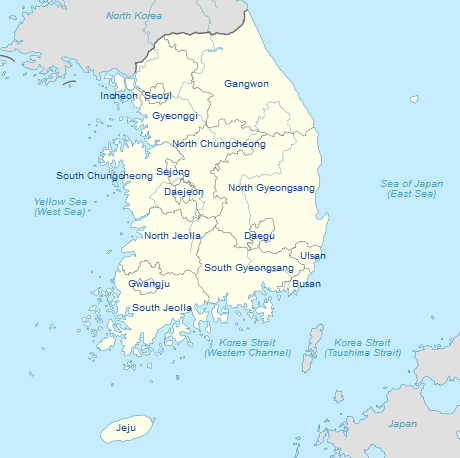South Korea
Map Courtesy CIA World Factbook |
South Korea, officially the Republic of Korea, is a country in East Asia, covering the southern half of the Korean Peninsula. To the north, the Republic of Korea borders North Korea, with which it formed a single nation until 1948. Its division was finalized by the Korean War. Japan lies across the sea. The country is commonly called Hanguk ("Han Nation") or Namhan ("South Han") by South Koreans and Namjosŏn ("South Chosŏn") in North Korea. The capital is Seoul.
After the end of World War II, the world's superpowers divided Korea into two zones of influence. In 1948, two matching governments were formed: a communist North and a United States-influenced republic South. In June 1950, the Korean War broke out. The United Nations-backed South and the USSR-backed North eventually reached a stalemate and an armistice was signed in 1953, splitting the peninsula along the demilitarized zone at about the 38th parallel, which had been the original demarcation line.
Thereafter, South Korea, under the autocratic government of Syngman Rhee and the dictatorship of Park Chung Hee, achieved rapid economic growth. In 1980 Park Chung Hee was overthrown in a military coup which in turn brought General Chun Doo-hwan into power. Massive student demonstrations in the spring of that year resulted in a military crackdown and the Gwangju Massacre. During this time a US general retained ultimate operational control over joint US-South Korean forces. Civil unrest dominated politics until protests succeeded in overthrowing the dictatorship and installing a more democratic form of government in the late 1980s with the election of Roh Tae-woo to the presidency. In the 1990s, South Korea became one of the world's largest economies. In 1996 South Korea joined the OECD. Today, South Korea is a fully functioning modern democracy and one of Asia's most affluent nations.
A potential Korean reunification has remained a prominent topic; no peace treaty has yet been signed with the North. In June 2000, a historic first North-South summit took place, part of the South's continuing "Sunshine Policy" of engagement. Since then, regular contacts have led to a cautious thaw. However, there have been recent concerns over the North's nuclear weapons program.

